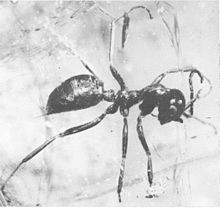Sphecomyrma freyi
|
Sphecomyrma Temporal range: Turonian–Campanian, 92–79 Ma |
|
|---|---|
 |
|
| S. freyi worker, holotype | |
| Scientific classification | |
| Kingdom: | Animalia |
| Phylum: | Arthropoda |
| Class: | Insecta |
| Order: | Hymenoptera |
| Family: | Formicidae |
| Subfamily: | †Sphecomyrminae |
| Tribe: | †Sphecomyrmini |
| Genus: |
†Sphecomyrma Wilson & Brown, 1967 |
| Type species | |
|
Sphecomyrma freyi |
|
| Species | |
|
|
Sphecomyrma is an extinct genus of ants which existed in the Cretaceous approximately 79 to 92 million years ago. The first specimens were collected in 1966, found embedded in amber which had been exposed in the cliffs of Cliffwood, New Jersey, by Edmund Frey and his wife. In 1967, zoologists E. O. Wilson, Frank Carpenter and William L. Brown, Jr. published a paper describing and naming Sphecomyrma freyi. They described an ant with a mosaic of features, a mix of characteristics from modern ants and aculeate wasps. It possessed a metapleural gland, a feature unique to ants, it was wingless and possessed a petiole which was ant-like in form. The mandibles were short and wasp-like with only two teeth, the gaster constricted and the middle and hind legs had double tibial spurs. The antennae were, in form, midway between the wasps and ants, having a short first segment but a long flexible funiculus. Two additional species, S. canadensis and S. mesaki, were described in 1985 and 2005 respectively.
The genus is among the earliest known ants to roam the earth and at the time was considered to be the evolutionary link between ants and wasps. It was suggested that ants diverged from tiphiid wasp ancestors, but later studies show that they originate from a different clade. It shows resemblance to extant primitive ants such as Nothomyrmecia and members of the tribe Aneuretini. Some scientists, however, doubted the nature of these ants and believed they were wasps, due to the possible absence of the metapleural gland in Sphecomyrma and short scapes which are key diagnostic traits for ants. Additional specimens collected proved Sphecomyrma was an ant as the metapleural gland was identified. Further fossil evidence and the slender body and large compound eyes suggest that they were epigaeic, foraging socially above ground and out in open areas. The sphecomyrmines, including these ants, most likely vanished by the end of the Mesozoic.
...
Wikipedia
